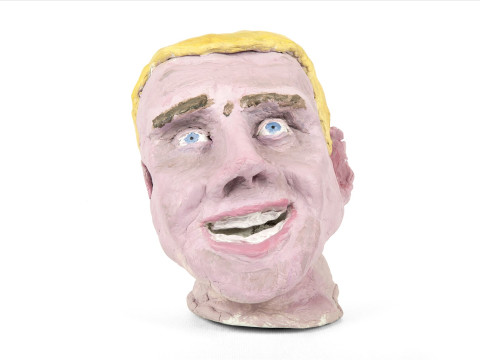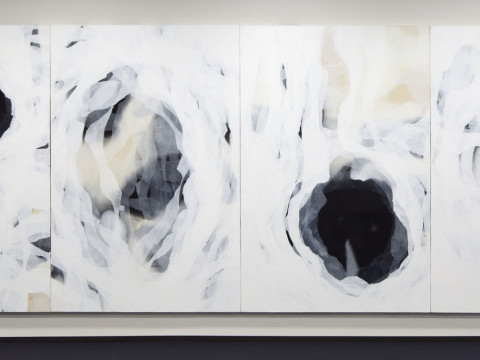
Munch's influence on women artists
By Patricia Berman
Published on 20 October 2020
Art historian Patricia Berman traces Edvard Munch's surprising influence on women artists, from Tracey Emin RA and Marlene Dumas Hon RA, to Louise Bourgeois and Maria Lassnig.
Patricia Berman is a Professor of Art at Wellesley College, Massachusetts and an expert in Scandinavian art.
"The Hedgehog raises its bristles against the baying of Dogs
If the spines are torn off what remains is a sensitive defenceless Animal" – Edvard Munch.
Edvard Munch has the reputation of being one of modern art’s foundational misogynists. The Norwegian artist’s lifelong expression of his own frailty also made him one of modern art’s great self-confessionalists. Paradoxically, his problematic revelation of pain and unresolved trauma has made him a kind of mentor to generations of women who explore the body and memory, and the body as memory, in their art.
One such woman is the artist Tracey Emin RA. With the RA’s contemporary art curator Edith Devaney, she is curating the Academy’s show of her own work alongside Munch’s this autumn. Emin sees in the art of the Norwegian a vulnerability rarely acknowledged by a man, an empathy towards women, and a direct communication of the unstable terrain of psychic life.
In a recent interview she gave to Devaney for the show’s catalogue, Emin reflected, "I think mainly I just felt emotionally that “he’s one of me”, “I’m one of him”, and that he was my friend in art." Munch’s work is part diaristic and part autofiction, rooted in his memories and perceptions. He responded to remembered feelings of euphoria and loss by mutating the bodies he represented and the spaces they inhabit: his figures sometimes drown in paint, evaporate into pure gestural line, or seem to implode from the percussive brushwork throughout his canvases – like his most famous work, The Scream (1893). The very matter of Munch’s art – its insistent materiality and its sense of wrenching personal disclosure – resonates with Emin’s credo, as outlined to Devaney: "the most beautiful thing is honesty, even if it’s really painful to look at". Munch’s experimentation with media and with the representation of the self affirm Emin’s own project of memory and disclosure.

Once Munch invented a motif, he often repeated, reimagined and reinterpreted it over many years. Emin’s exhibition at the Academy, Tracey Emin / Edvard Munch: The Loneliness of the Soul, includes such a painting, The Death of Marat (above), one of a small group of images bearing that title and understood to be autobiographical. It pictures a pale, naked, red-haired woman, facing directly forward. Behind her, a man lies prostrate on a bed, his dark red hand dangling over the floor. A flurry of red paint, ostensibly staining the surface upon which he rests, also seems adhered to the canvas surface like the evidence of a crime scene in the viewer’s space in real time. The title refers to the murder of the French revolutionary Jean-Paul Marat in 1793 by another revolutionary, Charlotte Corday, memorialised in a celebrated painting by Jacques-Louis David.
Munch recalled Marat, the murder victim, and Corday, the perpetrator, as proxies for his own history: Munch and Mathilde ‘Tulla’ Larsen had been lovers for several years when the relationship ended grotesquely with a pistol shot to the artist’s hand in 1902. In that year, Munch created a painting of a bloodied male body lying on an operating table, and in succeeding years, paintings and prints variously entitled The Murderess and Death of Marat mirrored that recumbent figure. Bordering on obsession, his notebooks and letters recall Larsen, their relationship and the mutilation. Munch, as well as his supporters and historians, cast Larsen as a kind of virago intent upon destroying the martyred artist: "My and my beloved’s child, The Death of Marat, which I carried with me for nine years, is not an easy painting… If you like, tell my enemy that the child has now been born and christened…". This episode, an earlier failed love affair and paintings such as this, have, over the years, entered into art history to mythologise the artist as an architect of the turn-of-the-century femme fatale, the Fatal Woman who deploys her sexuality to consume and destroy men. More discerning eyes, like Emin’s, intuit the eruptive forces – marshalled by memory and embodied in paint – that imprison both men and women.

The Death of Marat seems to constrain its protagonists in its structural brushwork and dissonant colours, and its agitated calligraphy calls forth the artist’s own mobile brush in the making of the painting. The immediacy, even frenzy, of touch, and the painful deployment of bodies, speak across time and space to Emin’s own work. Her paintings translate living bodies into taut seismic forms; her study of academic figure drawing enables her to know bodies from the outside and inside, to have the capacity to link eye, hand and canvas to make linear gestures read as emotional discharges in works such as It - didnt stop - I didnt stop (above). The directness and integrity of her images and the proposal of the body as a battleground, and of memory as vital sensation – the abject and the elated – communicate with Munch’s own intimate disclosures.
South African artist Marlene Dumas Hon RA wrote the brief essay entitled Munch – and Why I Like Him in 2016, describing his canvases (and The Death of Marat in particular) as "breathing anxiety which is caused by the dynamic movements of his brush strokes". She recalls that at school in South Africa, "everyone knew Munch but you didn’t really look at him. Munch was a sort of a person with a history made by the art historians". But Dumas became riveted by Munch’s work and sees in it not, as she says, a flattened meaning made by others, but a directness about bodies and sensation, emotion and touch.
Munch never married. He had affairs that did not last. Does that disqualify him from having painted the most touching kissing couples of the 20th century?
Marlene Dumas Hon RA
Her painting Omega’s Eyes is in fact inspired by a lithograph by Munch from his 1907 series Alpha and Omega. Dumas, who in 2018 curated the exhibition Moonrise: Marlene Dumas & Edvard Munch at Oslo’s Munch Museum, articulates what she sees as the authenticity of impassioned sensation: "Munch never married. He had affairs that did not last. Does that disqualify him from having painted the most touching kissing couples of the 20th century? Apart from Picasso, which modern artists even tried to paint the passions of kissing and crying? The frictions between love and lust? Picasso gives us sexual acts… Munch invites us to desire… The transformative sensations of attraction, of falling in love. I may not believe in two becoming one, but I raise a glass to him as he succeeded in showing some of those moments through paintings that never pretend to be what they are not. No illusionism, all suggestion. Every gesture can be traced."
Munch’s physicality as a painter, and the liberties he took with his own body in representation, were among the Austrian painter Maria Lassnig’s inspirations. "Together with Vermeer and Titian, Munch is among the three painters most important to me, and whom I revere," she stated. Painting only the parts of her body as she felt them directly, and suppressing what one learns of academic anatomy, Lassnig insistently painted what she termed "body awareness", self-images rendered from the inside out (Self-portrait with Saucepan). "The truth," she once explained, "resides in the emotions produced within the physical shell", rather than through sight alone. Her work probed what it was like to live and paint in her body, an exploration of subjectivity registered as mutated bodily forms and heightened colour that vibrates optically.
Munch’s perspective in such a painting as Model by the Wicker Chair was an experiment in bodily experience as a subject in itself. Tilting the floor radically up, the artist perceived the model’s head pressed and oppressed by the sunken, warped plane of the ceiling. The sense of dislocation of both model and artist is conveyed through the many adjustments to the room as an envelope. With her face generalised to an obscured, one-eyed oblong and the top of her head and her feet cut off by canvas edges, the model looms over the painter. Feeling trapped, perhaps, or besieged by the aggressive patterns and colours of the chair, Munch mapped his sensorium onto the painting.

Munch’s emphasis on deeply felt emotions, filtered through memory and made visible in art, offered an arena that the French artist Louise Bourgeois forthrightly mined. "The subject of pain is the business I am in. To give meaning and shape to frustration and suffering," she wrote. "When does the emotional become physical? When does the physical become emotional? It’s a circle going around and around." Emin, who admired Bourgeois and collaborated on a project with her before the latter’s death in 2010, said, "The thing I really loved about Louise Bourgeois was that she wasn’t afraid of her emotions… Women are actually much better at this kind of thing than men, and Bourgeois wasn’t the Queen of this, she was the King."
Bourgeois struggled in her art with issues of sexuality and the body, using a wide range of media, including textiles whose very materiality referred to her family’s profession as tapestry repair artists. The sewn and stuffed fabric figures in Couple share Munch’s enigmatic exploration of the precariousness of sexuality. The erotic proximity of the two bodies in Bourgeois’ sculpture is both undermined and enhanced by the indefinite boundaries of the figures’ napped contours and their potentially disastrous suspension in space. Even in the midst of the most erotic of encounters, Munch suggested the wreckage of its aftermath, a push-pull whose familiarity has been magnetic to artists like Bourgeois, committed to intimate revelation.

The Norwegian artist has been dead for nearly as long as he walked this Earth, but the artist and his paintings and prints seem, for Emin, present, inhabited, even haunted. "When you go to the Munch Museum in Norway," she said in an interview for The South Bank Show, "you actually look at his bed and you think, “Oh, he has slept in there.” It becomes important… You can touch it… and it’s like an alchemy, a transmission of substance. Something happens." This sense – of the conveyance of ‘substance’ or matter – accumulates in Emin’s film Homage to Edvard Munch and all my Dead Children (above; not in exhibition), in which the dreamy setting of water, sky and the artist’s coiled naked body is abruptly shattered by a horrific scream that seems to go on forever. Although the film is only one minute long, the scream enters and shakes you to your very core, resonating like an afterimage. It calls forth Munch’s most famous motif, The Scream, animating it and reinventing it. Munch’s ‘substance’ may be tangible to Emin, but her own work also activates Munch’s, making his art alive and relevant, perhaps helping to catalyse her own feminist disclosure. In this way, their art and selves are entwined: her breakthrough work My Bed (1998), his bed, their bodies, and their bodies at work making other bodies happen, share matter.
From the Autumn 2020 issue of RA Magazine, issued quarterly to Friends of the RA. Tracey Emin / Edvard Munch: The Loneliness of the Soul runs from 15 Nov – 28 Feb 2021. This exhibition has been organised by MUNCH, Oslo, Norway, in partnership with the Royal Academy of Arts.

Enjoyed this article?
As well as free entry to all of our exhibitions, Friends of the RA enjoy one of Britain’s most respected art magazines, delivered directly to your door. Why not join the club?


